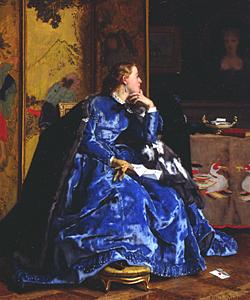
october 18, 2000–april 8, 2001
the blue dress
Also known as The Duchess, this painting was one of eighteen paintings Stevens exhibited at the Exposition Universelle in Paris in 1867, forming a mini-retrospective that confirmed his status in this crucial decade. Emerging at the Salons of Brussels and Paris in the 1850s with works that offered a romanticized vision of medieval history, Stevens then explored a version of Gustave Courbet's new social realism. From the later 1850s, Stevens also re-examined the legacy of Dutch seventeenth-century artists, whose genre paintings validated the democratic turn to the representation of the everyday world of contemporary bourgeois social rituals and experiences as a topic for serious painting. The list of subjects for the paintings shown in 1867 reads like an echo of Vermeer, Terborch, and Metsu: writing and receiving of letters, intrigue, condolence, tea parties, studio scenes, social visits. This same list anticipates the work of Mary Cassatt or her French and American contemporaries, like William Merritt Chase, who owned more than ten paintings by Stevens. Possibly dating from 1861, The Blue Dress shows an expensively dressed married woman of high society who has just returned home; she is still wearing one glove. An opened letter rests on her knees while she, in a pose reminiscent of Ingres, contemplates a dim portrait (her younger self? a lost relative?). This very Parisian woman is framed by a lacquered Japanese screen and a Chinese table-hanging showing two herons. The painting plays with allusions to depth (the suggestion of the layered spaces of a room inside a stylish apartment) and with surfaces: the gilded screen, the hanging, the paintings, and above all the expanse of saturated blue velvetvery fashionable in 1861from which peeks one tiny foot, the trace of the body swathed, camouflaged, and reshaped by a costume as exotic and marvelous as the other worlds of kimonos and birds shown on the Japanese works of art. Stevens was one of the firrst painters to become interested in the Asian artifacts and arts that began to be imported into Paris in the early 1860s, anticipating Whistler's orientalized works by several years.

